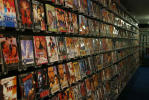June 25, 2003 – One obstacle retailers face in using RFID to track individual items in stores is the huge cost of retrofitting shelves with readers, which can cost more than $1,000 each. MeadWestvaco, the Stanford, Conn.-based paper and packaging giant, has developed networking technology could greatly reduce the cost of smart shelves. Tesco, the UK’s largest retailer, is testing it during a three-month pilot.
MeadWestvaco got into RFID as part of its smart packaging efforts. The company quickly realized that smart packaging would be useless unless there were smart shelves. “We realized that we had the light bulb, but there was no electricity,” says Ronnie Hise, general manager of MeadWestvaco’s Intelligent Systems (MWVIS) division. “There was nothing out there and nothing practical on the horizon to interact with our smart packaging.”
The company began looking to develop low-cost smart shelves. Instead of trying to make cheaper readers or cheaper antennas for the readers, it developed network technology — dubbed the Intelligent Systems RFID Solution — that allows one standard, commercial reader to control hundreds of antennas. Today, most readers can control four or possibly eight antennas. For competitive reasons, Hise declined to provide details of how the system works, but he says the MWVIS system appears to be orders of magnitude cheaper than anything else available today.
Tesco is running a three-month test of the technology in the UK. MeadWestvaco is working with Entertainment UK (EUK), the category-management company that keeps DVDs stocked in 2,500 retail stores in the UK, including Tesco’s flagship Sandhurst store, near London, where the tests is being run. DVDs are tagged and programmed, using MWVIS technology, in two of EUK’s modern distribution centers.
For the pilot, MeadWestvaco retrofitted 10 commercial gondolas — four-foot by six-foot shelving units — with 13.56 MHz readers from Philips Semiconductors. Two readers power hundreds of antennas using the MWVIS networking technology. (The shelves could have used one reader, but the installation was done in two phases.)
Last week, MWVIS and EUK also installed the technology in the backroom of the Tesco store. Now, staff at Tesco and Entertainment UK can log onto a secure Web site and see, in near-real time, exactly what’s in the store. “The value proposition that Tesco is looking for is customer satisfaction,” says Hise. “They want their customers to find what they want, when they want it every time they come in the store.”
The technology is designed to work with the Electronic Product Code technology developed by the Auto-ID Center. It can be adapted to work with tags and readers operating in the UHF band, or 2.45 GHz, or with tags and readers based on ISO standards. A software interface lets staff see when goods are out of place or need to be restocked.
Hise says that unlike other smart shelf pilots, this one is not trying to determine whether or not the technology works, but rather whether there is a business case for deploying it widely. It may well give Tesco and other retailers a way to implement RFID at the item level sooner than anyone previously envisioned.
With most RFID innovations, there is usually a tradeoff that comes with making something fast or cheaper, and that is the case here. Because the reader is cycling through so many antennas, the data is not real time. It takes the reader a few minutes to check all of the shelves. That means the technology won’t be suitable for some applications. For instance, Gillette’s smart shelf monitors inventory in real time and when someone swipes 10 packages of razors, the system takes a photo of the potential thief and alerts staff that someone might be stealing goods.
The MWVIS technology would work for that kind of an application but it would need more readers, which would eliminate some of the cost advantages of the technology. With fewer readers, it might take several minutes to find out 10 items had been removed. On the other hand, by giving retailers a much less expensive way of keeping track of what’s on the shelves, the MWVIS technology would not only help store managers reduce out of stocks; it would also enable them to better pinpoint where shrinkage is occurring.
The system puts a time stamp next to each movement of a product. So if a dozen DVDs left the backroom at 4:47 PM and never got to the shelf, the retailer could check who had access to the backroom at that time and focus the investigation on those employees that had access.
CVS is planning to launch a pilot with MWVIS later this year in its pharmacies. Pharmacists don’t enjoy taking inventory, so the technology would automate the task of tracking of expensive prescription drugs. Another major headache for pharmacies is removing goods that have passed their sell-by date from the shelves. The low-cost networking technology could make that task a breeze.
MeadWestvaco set up MWVIS to develop this technology the way a startup would. Hise says his unit plans to begin commercializing the technology by the beginning of next year. “I’m cautiously optimistic,” he says. “The value proposition looks good to us, and the purpose of the trials is to validate this view.”


